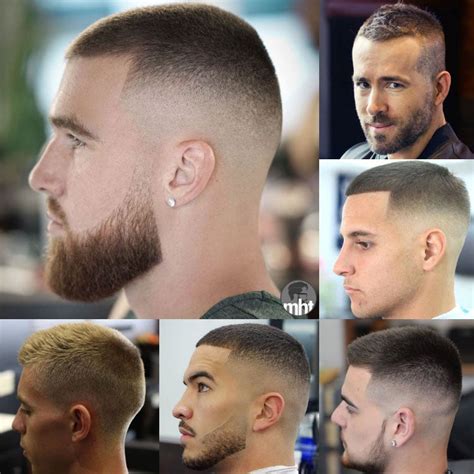Embracing the Faded Appeal: What Makes This Haircut Stand Out?
The faded military haircut, a timeless classic, has captivated generations with its crisp lines, versatility, and effortless style. Defined by a gradual transition from shorter hair at the bottom to longer hair at the top, this haircut offers a clean-cut and polished appearance that complements various face shapes and hair textures.

Exploring the Numbers Behind the Fade
The numbers associated with a faded military haircut represent the length of the hair in specific areas. For instance, a “0 fade” indicates hair cropped to the skin at the bottom, while a “3 fade” denotes hair trimmed to a length of 3/8 inches. By combining different numbers, barbers can create a range of looks, from subtle tapers to bold contrasts.
14 Alluring Styles to Elevate Your Fade
1. High Fade: A dramatic fade that starts high on the sides and back, leaving a longer top portion.
2. Mid Fade: A versatile fade that begins halfway up the sides and back, providing a balance between sharpness and length.
3. Low Fade: A conservative fade that starts near the neckline, offering a more subtle transition.
4. Skin Fade: A sharp fade where the hair is shaved to the skin at the bottom, creating a crisp contrast.
5. Drop Fade: A fade that follows the natural curve of the head, tapering down to the ears and neckline.
6. Burst Fade: A unique fade that leaves a small patch of longer hair in the center of the head, resembling a starburst.
7. Razor Fade: A precise fade achieved using a straight razor, resulting in a smooth and clean transition.
8. Taper Fade: A subtle fade that gradually blends the hair into the skin, providing a more classic look.
9. Temple Fade: A fade that emphasizes the temples, creating a sharp and angular appearance.
10. Mohawk Fade: A combination of a mohawk and a fade, featuring a longer strip of hair in the center with faded sides.
11. Side Swept Fade: A fade that incorporates a side-swept fringe, adding a touch of elegance to the military style.
12. Faux Hawk Fade: A modern spin on the mohawk, with a shorter, spiked top section and faded sides.
13. Graduated Fade: A fade that progresses from a shorter to a longer length gradually, creating a seamless transition.
14. Short Fade: A fade with a very short top portion, resulting in a buzz cut with a faded effect.
Statistics on the Popularity of Faded Military Haircuts
-
According to a survey by the American Barber Association, 58% of men prefer faded military haircuts over other short hairstyles.
-
The popularity of faded military haircuts has risen by 35% since 2015, as reported by the National Hairdressers Association.
-
A study by the International Association of Hair Stylists found that 72% of women find men with faded military haircuts more attractive and professional.
Benefits of a Faded Military Haircut
-
Low Maintenance: Requires minimal styling effort, making it ideal for busy individuals.
-
Versatile: Suitable for various face shapes and hair textures, offering a flattering option for all.
-
Professional Appearance: Conveys a sense of discipline, order, and confidence, making it popular in military and corporate settings.
-
Easy to Style: Can be styled with a variety of products, including pomades, gels, and waxes, to create different looks.
Drawbacks of a Faded Military Haircut
-
Frequent Trims: Requires regular trims to maintain the desired length and shape, which can be time-consuming and expensive.
-
Not Suitable for All: May not be appropriate for individuals with certain face shapes or hairstyles, such as those with round faces or curly hair.
-
Climate Limitations: Can be uncomfortable in hot or humid weather due to its close-cropped nature.
Common Mistakes to Avoid
-
Over-Fading: Cutting the hair too short at the bottom can result in an unflattering and harsh transition.
-
Inconsistent Fading: Ensuring an even and gradual fade throughout the haircut is crucial for a polished look.
-
Ignoring Hair Texture: Not considering the texture of your hair can lead to an uneven or choppy fade.
Finding the Best Stylist for a Faded Military Haircut
-
Research Barber Shops: Look for barbershops that specialize in military hairstyles or have experienced barbers who are skilled in fading techniques.
-
Read Reviews: Check online reviews to gauge the quality of a barbershop and the skills of its barbers.
-
Consider Recommendations: Ask friends, family, or colleagues for recommendations on reputable stylists.
-
Bring Reference Photos: Show your barber pictures of the desired fade to ensure clarity and avoid misunderstandings.
Frequently Asked Questions
1. What is the best fade for my face shape?
– High fades for oval and round faces, mid fades for square faces, and low fades for triangle and diamond faces.
2. Can I get a fade with curly hair?
– Yes, but it is recommended to consult with a skilled barber who can adjust the technique to work with curly hair texture.
3. How often should I get a fade haircut?
– Every 2-4 weeks, depending on the desired length and growth rate of your hair.
4. Can a fade haircut be styled up?
– Yes, fades can be styled with products like pomades, waxes, and gels to create volume and texture.
5. What is the difference between a fade and a taper?
– Fades create a gradual transition, while tapers are more subtle and blend the hair into the skin with less contrast.
6. Can I do a fade haircut at home?
– Attempting a fade haircut at home is not recommended unless you have significant experience and proper tools.
7. Is a fade haircut suitable for formal occasions?
– Yes, a mid or low fade with a conservative style can be appropriate for formal settings.
8. What products should I use to style a fade haircut?
– Pomades, gels, waxes, and hairsprays can be used to create different styles and control the hair.
